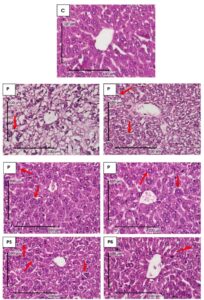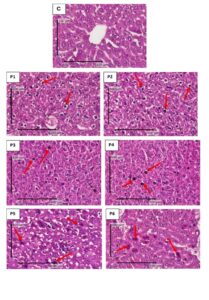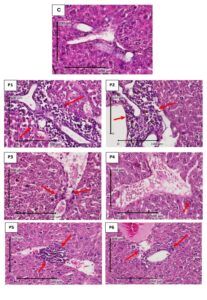The Potential of Kebar Grass (Biophytum petersianum Klotzsch) on the Liver Histopathology of Lactating Mice (Mus musculus) Exposed to Carbofuran
Muhammad Andika Aulia Rakhman1, Sri Hidanah1, Widjiati1, Thomas Valentinus Widiyatno1, Ratna Damayanti1, Viski Fitri Hendrawan2, Epy Muhammad Luqman1*
Abstract
This study aims to determine the potential of Kebar grass extract in reducing the impact of liver damage in mice (Mus musculus) during lactation exposed to carbofuran. The 42 lactation mice (Mus musculus) used in the study were divided into seven groups, each group consisting of six mice. Carbofuran, chewed grass, and vitamin C are exposed orally on days 1 to 14 after birth. This group consisted of C (aquadest control), P1 (carbofuran 0.0125 mg/day), P2 (carbofuran 0.00625 mg/day), P3 (carbofuran 0.0125 mg/day+extract of kebar grass 3.375 mg 0.2 ml), P4 (carbofuran 0.00625 mg/day+extract of kebar grass 3.375 mg 0.2 ml), P5 (carbofuran 0.0125 mg/day+vitamin C 5 mg 0.2 cc), and P6 (carbofuran 0.00625 mg/day+vitamin C 5 mg 0.2 cc). On the 15th day after birth, mice were sacrificed and their liver organs taken for microscopic examination with hematoxilin-eosin staining. The results of this study indicate that the liver histopathology of mice suffered damage characterized by an increase in the number of inflammation cell, degeneration, and necrosis in line with the carbofuran dose given during the lactation period (P1 and P2). The administration of kebar grass extract (P3 and P4) is more effective than vitamin C (P5 and P6) in reducing the amount of inflammation cell, degeneration, and hepatocyte necrosis caused by carbofuran administration in lactation mice. This can be seen in the amount of liver damage in group P3 and P4 mice less than the amount of liver damage in group P5 and P6.
Keywords
carbofuran; kebar grass; lactation; liver; pesticide stress
Cite This Article
Rakhman, M. A. A., Hidanah, S., Widjiati, Widiyatno, T. V., Damayanti, R., Hendrawan, V. F., Luqman, E. M. (2022). The Potential of Kebar Grass (Biophytum petersianum Klotzsch) on the Liver Histopathology of Lactating Mice (Mus musculus) Exposed to Carbofuran. International Journal of Scientific Advances (IJSCIA), Volume 3| Issue 2: Mar-Apr 2022, Pages 185-192, URL: https://www.ijscia.com/wp-content/uploads/2022/03/Volume3-Issue2-Mar-Apr-No.238-185-192.pdf
Volume 3 | Issue 2: Mar-Apr 2022






